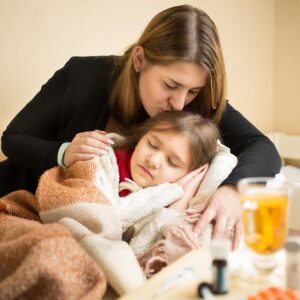Snoring is a noise that occurs during sleep when the child is breathing and there is a blockage in the air passage at the back of the nose. About 1-3% of children not only snore but also suffer from breathing problems during sleep. Children who are 3 yrs or older tend to snore during deeper stages of sleep. For up to 10% of children who snore it can be a sign of more serious problem ,like Obstructive sleep apnea syndrome(OSAS).primary snoring is defined as snoring that is associated with more serious problems such as OSAS or frequent arousals from sleep. Sometimes snoring is a sign of respiratory infection, stuffy nose or allergy but otherwise it may be a symptom of sleep apnea which is seen in more than 90%of cases.
When snoring is accompanied with gasps or pauses in breathing or if accompanied by thrashing in bed ,they could be a sign of a more serious condition. Undiagnosed and untreated sleep apnea may cause day time sleepiness and behavioral problems including difficulties at school. So it is recommended that all children with snoring to be screened to know if the child has primary snoring or OSAS.
What causes sleep apnea:
- Obesity
- Respiratory infections
- Allergies
- Enlarged tonsils and adenoids
- Deviated nasal septum
What to look for at night in a child with OSAS:
- Child snores for 3 or more nights per week
- Child’s breathing is accompanied by gasps or pauses
- Sweating profusely during sleep
- Restless sleep with frequent awakenings
- Sleeping with head in unusual positions
- Sleeping with mouth open
- Frequent bed wetting
What to look for during the day in a child with OSAS:
- Excessively sleepy during the day
- Difficult to wake up in the morning
- Having any learning, behavioral or social problems
- Often irritable, cranky, agitated or aggressive
- Speak with nasal voice
- Breathing primarily with their mouth
What if OSAS is left untreated:
- Behavioral problems including difficulties at school with learning problems ,decreased focus and concentration and lowered IQ
- Poor physical and mental development
- Feeding problems
- Decreased hearing due to Eustachian tube block(in children with huge adenoids)
- Cognitive and psychological problems
- Facial changes occur due to prolonged mouth breathing (Adenoid Facies)

Types of treatment:
- Weight reduction if excess weight is the issue
- Medical treatment includes avoiding the allergens and treating the upper respiratory infections and allergies which can cause the airway obstruction .
- Surgical treatment is opted when medical treatment fails . if the problem is due to large adenoids and tonsils a surgery to remove adenoids and tonsils is recommended.
Adenotonsillectomy:
There are various methods of performing the surgery. Newer and most advanced method being plasma mediated ablation COBLATION. This device melts the tissues at low temperatures( 60-70 degrees C) with minimal collateral thermal tissue damage ,hence also termed as Cold Ablation.

Advantages being:
- Less operative time
- No intra operative blood loss
- Less post operative pain
- Early recovery
